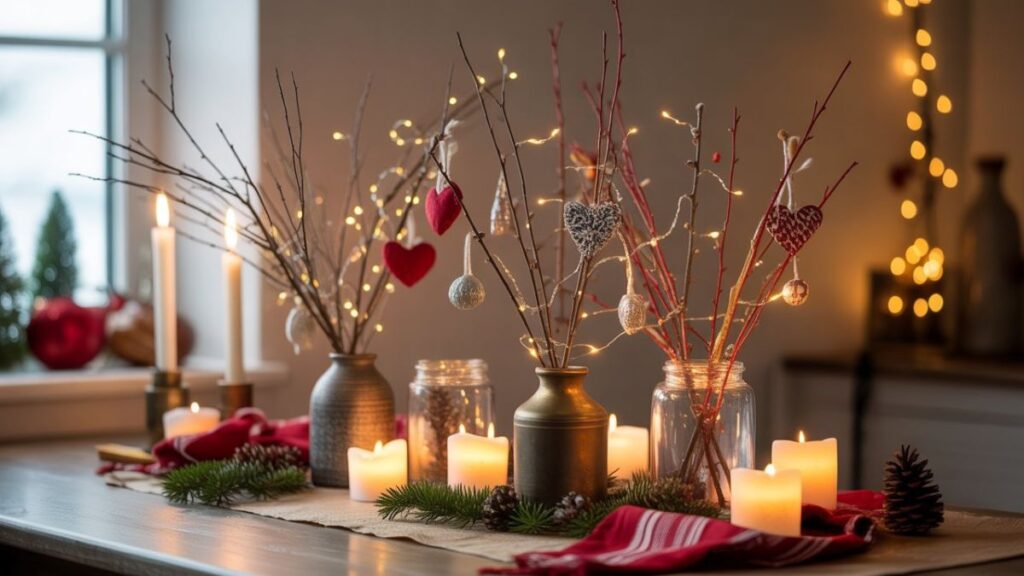In the heart of Scandinavian homes during the dark, quiet months of winter, a subtle but powerful symbol of light, life, and tradition graces windows, mantels, and tabletops. These delicate, branching arrangements—known as pyntekvister—are far more than simple decorations. Rooted deeply in Nordic folklore, seasonal rituals, and the practical realities of long winters, pyntekvister (a Norwegian and Danish term translating roughly to “decorative twigs”) embody a cultural aesthetic that values simplicity, nature, and mindful celebration.
While pyntekvister may appear as nothing more than bare branches adorned with candles, ribbons, or dried botanicals, their presence in homes across Norway, Sweden, and Denmark carries centuries of meaning. In recent years, as global interest in hygge, minimalism, and sustainable décor has grown, pyntekvister have found a new audience beyond their Nordic origins. This article explores the history, symbolism, crafting techniques, and contemporary relevance of pyntekvister, offering readers a comprehensive understanding of why these humble twigs continue to inspire warmth and wonder during the holiday season—and beyond.
What Are Pyntekvister?
Pyntekvister literally means “decorative twigs” in Danish and Norwegian. The term combines “pynt” (decoration or adornment) and “kvist” (twig or small branch). Traditionally, pyntekvister are made from naturally foraged branches—often birch, willow, or cherry—stripped of leaves and arranged in vases or stands. They are then embellished with seasonal elements: candles, dried citrus slices, pinecones, berries, ribbons, or even miniature ornaments.
Unlike the full-bodied Christmas tree or elaborate garlands common in other cultures, pyntekvister emphasize minimalism and the beauty of negative space. Their sparse, open structure allows light to filter through, casting delicate shadows that dance across walls—a poetic counterpoint to the long, dark Nordic winters.
The use of pyntekvister is especially prevalent during Advent and the Christmas season, but they can also appear during Easter, Midsummer, or other seasonal festivals, depending on how they are adorned. Their versatility and connection to the natural cycle of the year make them a uniquely Scandinavian form of living art.
Historical Roots and Cultural Significance
The tradition of using branches as indoor decorations predates Christianity in Scandinavia. In pre-Christian Norse culture, evergreen boughs and leafless twigs were brought into homes during the winter solstice (Yule) as symbols of enduring life and protection against malevolent spirits. The belief was that nature held spiritual power, and by inviting a piece of the outdoors inside—even in its dormant form—one could harness that energy for health, fertility, and good fortune.
With the arrival of Christianity, many of these pagan practices were adapted rather than erased. The barren branches of pyntekvister came to symbolize the waiting and anticipation of Advent—the period of preparation before Christmas. In this context, the twigs represent both the starkness of a world awaiting salvation and the promise of renewal, echoing biblical themes of hope and rebirth.
In rural Scandinavian communities, where resources were scarce and winters long, pyntekvister offered an accessible and sustainable way to celebrate. Families would gather branches from nearby woods, clean and arrange them, and decorate using only what they had: beeswax candles, hand-dyed wool, or preserved fruits. This frugal elegance became a hallmark of Nordic design and remains central to the ethos of pyntekvister today.
Symbolism and Meaning
Every element of pyntekvister carries symbolic weight. The bare branches themselves represent dormancy and potential—the quiet before the spring burst of life. When adorned with candles, they become beacons of light in the darkness, recalling the ancient solstice rituals meant to encourage the sun’s return.
Red berries or ribbons, commonly used in Christmas pyntekvister, symbolize vitality and the blood of Christ in Christian interpretations, while also echoing older associations with protection and life force. Dried oranges or apples speak to abundance, preservation, and the sweetness of life even in hard times.
Perhaps most importantly, pyntekvister embody the Scandinavian concept of friluftsliv—“open-air living”—which emphasizes a deep connection to nature regardless of the season. By bringing natural elements indoors in their rawest form, pyntekvister remind us that beauty exists even in simplicity and stillness.
In modern times, pyntekvister have also come to symbolize mindfulness and intentionality. In a world saturated with mass-produced decorations and flashy displays, the quiet elegance of pyntekvister invites a slower, more reflective approach to celebration.
How to Make Your Own Pyntekvister
Creating pyntekvister is a meditative and rewarding process that connects you to both nature and tradition. Here’s a step-by-step guide to crafting your own:
1. Choose the Right Branches
Look for flexible, well-branched twigs during late autumn or early winter, after leaves have fallen. Willow, birch, dogwood, and cherry are popular choices. Avoid green, sap-filled branches—they won’t dry properly and may mold. Cut branches should be 18–36 inches long, depending on your vase.
2. Prepare the Twigs
Clean the branches gently with a dry brush to remove dirt or loose bark. Let them dry indoors for a few days in a cool, well-ventilated space. This prevents warping and ensures longevity.
3. Select a Vase or Base
A tall, narrow vase or ceramic pot works best to hold the branches upright. Fill the base with pebbles, sand, or floral foam for stability. For extra Nordic flair, use handmade ceramics or recycled glass.
4. Decorate Thoughtfully
Less is more. Choose 2–3 decorative elements that complement the season:
- Advent/Christmas: Small LED or real candles (use caution), red wool ribbons, dried orange slices, cinnamon sticks, or sprigs of eucalyptus.
- Easter: Pastel-dyed eggs (real or wood), fresh forsythia blooms, or linen bows.
- General Winter: Frosted pinecones, white berries, or silver dusting for a frosty effect.
Secure decorations with thin wire, twine, or natural glue. For candles, use small holders or clip-on candle cups designed for branches.
5. Place with Purpose
Position your pyntekvister near a window to catch natural light or on a dining table as a centerpiece. Avoid direct heat sources if using real candles.
Making pyntekvister is not just about the final product—it’s about the ritual of gathering, preparing, and arranging. Many families turn this into a shared activity, passing down techniques and stories with each generation.
Pyntekvister in Modern Scandinavian Design
The global rise of Scandinavian interior design—characterized by clean lines, natural materials, and functional beauty—has brought pyntekvister into contemporary homes worldwide. Designers like Ilse Crawford and brands such as Ferm Living and Muuto often reference the aesthetic principles embodied by pyntekvister: simplicity, texture, and seasonal awareness.
In modern Nordic homes, pyntekvister are rarely over-decorated. Instead, they might feature a single white taper candle or a few sprigs of dried lavender, aligning with the “less but better” philosophy of designers like Dieter Rams. Social media platforms like Instagram and Pinterest have further popularized pyntekvister, with influencers showcasing minimalist holiday setups centered around a vase of artfully arranged twigs.
Importantly, today’s pyntekvister often reflect eco-conscious values. Many decorators use biodegradable materials, foraged elements, and reusable components—aligning with Scandinavia’s strong environmental ethics. This sustainability angle makes pyntekvister not just beautiful, but responsible.
Regional Variations Across Scandinavia
While the core concept remains the same, pyntekvister vary slightly across Nordic countries:
- Norway: Often called pyntekvister or julekvister (Christmas twigs), they are commonly displayed with red hearts made of woven paper or wool, a traditional Norwegian craft. Birch branches are favored for their pale, peeling bark.
- Denmark: Danes embrace pyntekvister as part of their hygge culture—creating cozy, candlelit atmospheres. Danish pyntekvister may include miniature Danish flags or traditional nisse (elf) figurines.
- Sweden: Swedes sometimes incorporate pyntekvister into their Adventsljusstake (Advent candle holder), blending twig arrangements with the four-candle Advent tradition. Light-colored branches with subtle gold accents are common.
These regional nuances highlight how a simple tradition can adapt to local identity while retaining its essence. Whether in Oslo, Copenhagen, or Stockholm, pyntekvister serve as a quiet, unifying thread in Nordic winter celebrations.
Why Pyntekvister Resonate Today
In an age of digital overload and fast-paced consumerism, pyntekvister offer a return to slowness and authenticity. Their handmade nature encourages presence and creativity. Unlike plastic Christmas trees or battery-operated decorations, pyntekvister are biodegradable, seasonal, and deeply personal.
Moreover, they align with growing mental health awareness. The act of foraging branches, arranging them mindfully, and lighting candles can be therapeutic—creating a ritual that grounds us in the present moment. This is especially valuable during the holidays, a time often fraught with stress and expectation.
The beauty of pyntekvister also lies in their inclusivity. They don’t require expensive materials or artistic skill. Anyone can gather twigs, place them in a jar, and add a ribbon. This democratization of beauty is central to Scandinavian egalitarian values—and part of why pyntekvister continue to thrive.
Caring for and Storing Pyntekvister
With proper care, pyntekvister can last through an entire season—and even be reused:
- Dust gently with a soft brush or cool blow dryer.
- Avoid moisture to prevent mold; never spray with water.
- Store flat in a dry box or closet after the season, wrapped in tissue paper.
- Refresh annually by adding new decorative elements—keeping the same branches for years creates a sense of continuity and personal history.
Many families pass down heirloom pyntekvister stands or specially crafted decorations, turning the tradition into a living archive of memories.
Conclusion: The Enduring Magic of Pyntekvister
Pyntekvister are more than seasonal décor—they are a quiet testament to resilience, hope, and harmony with nature. In their bare branches and simple adornments, we find a reflection of life’s cycles: dormancy and growth, darkness and light, solitude and togetherness.
As the world grows louder and more complex, the understated elegance of pyntekvister offers a sanctuary. They remind us that beauty doesn’t need to be loud or lavish to be meaningful. Whether you’re lighting a candle on a frosty December evening or arranging spring blossoms in April, pyntekvister invite you to pause, appreciate, and connect—with nature, with tradition, and with those you love.
In the hands of a new generation—one increasingly drawn to sustainability, mindfulness, and authentic experiences—the tradition of pyntekvister is not fading but flourishing. And as long as there are trees to shed their leaves and hearts to seek warmth in the winter, pyntekvister will continue to grace our homes, season after season.
From their ancient roots to their modern interpretations, pyntekvister remain a luminous symbol of what the Nordic spirit holds dear: simplicity, light, and the enduring magic of the natural world. Whether you call them pyntekvister, decorative twigs, or winter branches, their message is universal—and timeless.
So this year, step outside. Find a few branches. Light a candle. And let the quiet poetry of pyntekvister fill your home with warmth that no electric bulb can replicate.







